Archive:Enlargement countries - international trade in goods statistics
- Data from September 2013. Most recent data: Further Eurostat information, Main tables and Database.
This article is part of an online publication based on the pocketbook ‘Key figures on the enlargement countries – 2014 edition’ and focuses on the structure and evolution of the external trade in goods in the enlargement countries and in the European Union (EU). Both imports and exports are covered. It also provides information on the trade balance and a breakdown by selected product groups. A number of figures for international trade in goods have been aggregated (as a share of GDP) for the EU and for selected enlargement countries.
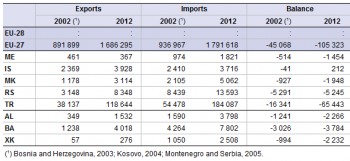
Source: for the EU aggregates, Eurostat (ext_lt_intertrd); for the enlargement countries, Eurostat (cpc_etmain)
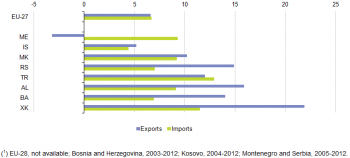
Source: for the EU-27, Eurostat (ext_lt_intertrd); for the enlargement countries, Eurostat (cpc_etmain)

Source: for the EU aggregates, Eurostat (ext_lt_intertrd) and (nama_gdp_c); for the enlargement countries, Eurostat (cpc_etmain) and (cpc_ecnagdp)
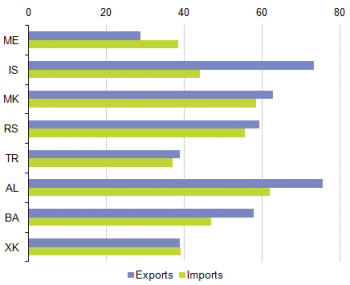
Source: Eurostat (cpc_etflow)
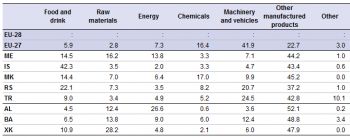
Source: for the EU aggregates, Eurostat (ext_lt_intertrd); for the enlargement countries, Eurostat (cpc_etsitc)
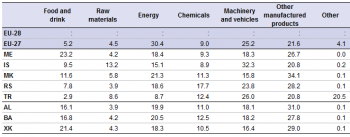
Source: for the EU aggregates, Eurostat (ext_lt_intertrd); for the enlargement countries, Eurostat (cpc_etsitc)
Main statistical findings
Deficits in external trade in goods in all of the enlargement countries, except Iceland
Despite the global financial and economic crisis that affected most economies from the second half of 2008 onwards, the total value of the goods exported by the EU to the rest of the world grew by almost 89 % between 2002 and 2012 (see Table 1). Only between 2008 and 2009, a considerable drop was registered, although the pre-crisis level of 2008 was again largely exceeded a year later. Between 2002 and 2012, every enlargement country except Montenegro and Iceland saw the value of their exports grow substantially faster than that of the EU: the value of Albania’s and Kosovo’s exports increased more than four-fold (Kosovo[1]: 2004-2012), that of Bosnia and Herzegovina (between 2003 and 2012) and Turkey more than three-fold. Serbia’s exports (between 2005 and 2012), and those of the former Yugoslav Republic of Macedonia, more than doubled. In contrast, Montenegro’s value of exported goods slightly decreased (between 2005 and 2012). In Iceland, a clear drop was recorded in 2009, but by 2011, the pre-crisis levels were largely exceeded again. The value of Iceland’s 2012 exports stood close to 66 % above the value of its 2002 exports.
The total value of the EU imports of goods increased nearly as fast as that of the exports: +91 % between 2002 and 2012. Similar relative increases were registered for imports of both Montenegro and Bosnia and Herzegovina (+87 % between 2005 and 2012 and +83 %, respectively between 2003 and 2012). In Serbia (+61 % between 2005 and 2012) and Iceland (+54 %), the increase was less strong. The remaining enlargement countries recorded rises well above the EU value, ranging between +140 % and +238 %. The latter value, most noteworthy, was registered in Turkey. The higher total value of exported goods as compared to that of imported goods meant that in 2012, Iceland was the only enlargement country registering a goods trade surplus (amounting to EUR 212 million). All the other enlargement countries recorded trade deficits, as did the EU.
As an indicator of the relative importance of goods trade in an economy, the EU exports of goods were equal to 13.0 % of the gross domestic product (GDP) in 2012 (see Table 3). In Montenegro (2012) and Kosovo (2011), this value was not attained. In all the other enlargement countries, on the other hand, the figure for exports as a percentage of GDP was higher, most notably so in the former Yugoslav Republic of Macedonia and in Iceland, where it amounted to 41.6 % (estimated value) and 37.2 % of GDP, respectively.
The EU imports were equal to 13.9 % of GDP in 2012. Far higher proportions were registered in all of the enlargement countries, especially in the former Yugoslav Republic of Macedonia, Bosnia and Herzegovina, Montenegro as well as Kosovo, where values reached more than 50 % of GDP in the latest year for which data are available.
The EU as a key trading partner for the enlargement countries
The EU is the main trading partner for the enlargement countries, although to varying degrees (see Figure 4). According to the most recent data available, over 70 % of the total value of goods exported by Albania and Iceland went to the EU; even the lowest proportion, recorded by Montenegro, amounted to around 29 %.
Nearly 39 % of the total value of goods exported by Turkey and Kosovo went to the EU while this share ranged between 58 % (Bosnia and Herzegovina) and 63 % (the former Yugoslav Republic of Macedonia) in other enlargement countries. For the imports of goods, the EU is somewhat less important: in Kosovo, Montenegro and Turkey, less than 40 % of the countries’ total imports arrived from the EU, while in Albania and the former Yugoslav Republic of Macedonia, levels revolved around 60 %.
Marine products of prime importance for Icelandic exports
‘Manufactured goods excluding machinery and vehicles’ (‘Other manufactured products’ in Table 5) made up by far the largest category of exports for all the enlargement countries. This category of goods accounted for 52 % of all goods exports of Albania. In the other enlargement countries, the share of this category in total goods exports was between 43 % and 49 %, except for Serbia where it amounted to 37 %. An important category for Turkey in 2012 was ‘Machinery and vehicles’ (25 %), as was also the case for the EU (42 %). In Serbia, ‘Machinery and vehicles’ (21 %) and ‘Food and drink’ (22 %) also represented a large share of total goods exports. Quite noticeable is the high share of ‘Food and drink’ registered by Iceland, which represented 42 % of the total value of all goods exports. Indeed, all of these goods were marine products, primarily demersal fish products (mainly cod and haddock).
‘Manufactured goods excluding machinery and vehicles’ was also the category which generally had the highest share in imports (see Table 6). Most of the enlargement countries registered nearly 30 % of their imports as falling into this category. The exceptions were Iceland and Turkey, where ‘Machinery and vehicles’ accounted for the highest share of imports of goods in 2012 (32 % and 26 %, respectively).For the EU, the share of ‘Machinery and vehicles’ in total imports amounted to 25 %, the second most important category after ‘Energy commodities’, the total value of which represented 30 % of all imports in 2012.
Data sources and availability
The annual questionnaires sent to the enlargement countries, as well as COMEXT, which is the Eurostat database containing detailed international trade data for the EU and its Member States, are the sources of international trade statistics. International trade statistics are normally recorded by enlargement countries on the basis of customs declarations submitted by the trader when clearing customs. The statistics on international trade were extracted from Eurostat's free dissemination database Easy Comext, which provides access not only to recent and historical data from the EU Member States and enlargement countries, but also to trade data for a significant number of third countries. The aggregated data on international trade and the detailed statistics which are disseminated from the Eurostat website are compiled from the COMEXT database on a monthly basis. Note that because COMEXT is updated on a daily basis, data published on the Eurostat website may sometimes temporarily differ from the data stored in COMEXT.
Context
Trade statistics are of prime importance for both public and private users, as they provide valuable information on the current trends in the exchange of goods within a specific geographical area as well as between geographical areas. Moreover, they enable the EU to prepare multilateral and bilateral negotiations on a common trade policy. Furthermore, international trade statistics support European businesses in their market surveys and improve their competitiveness.
The context in which trade statistics are collected has changed radically in recent years, not only within the European Union but also in enlargement countries. The economic impact of globalisation has had its effect on trade, as well as on the financial flows and the movement of persons linked to cross-border economic activity. In the light of the enlargement process of the European Union and taking into account the importance of trade for the enlargement countries, as well as for the ENP countries, the EU has been facing an unprecedented demand for high quality trade statistics to support EU policy decision-making.
See also
- Enlargement countries - statistical overview - online publication
- International statistical cooperation - online publication
Further Eurostat information
Publications
- Enlargement countries - International trade - 2014 edition
- Enlargement countries - International trade - 2013 edition
- Key figures on the enlargement countries - 2013 edition
Database
- Enlargement countries, see:
- Candidate countries and potential candidates (cpc)
- International trade (cpc_et)
- International trade, see:
- International trade data (ext)
- International trade long-term indicators (ext_lti)
- International trade short-term indicators (ext_sti)
- International trade detailed data (detail)
Dedicated section
Methodology / Metadata
External links
Notes
- ↑ This designation is without prejudice to positions on status, and is in line with UNSCR 1244 and the ICJ Opinion on the Kosovo declaration of independence.